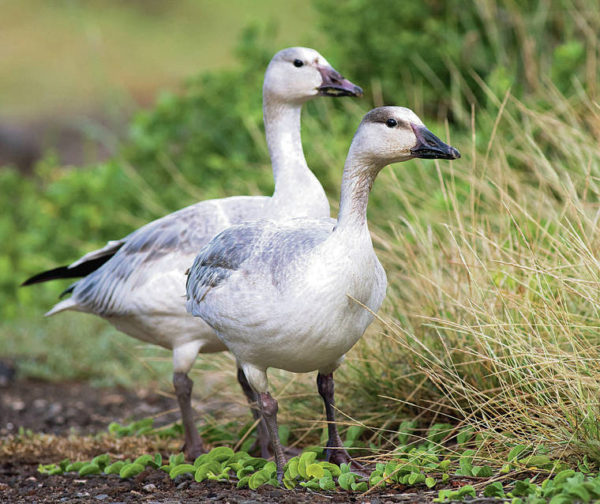Published in the Ocean Watch column, Honolulu Star-Advertiser © Susan Scott
December 7, 2019
I’ve been hiking to Kaena Point for decades, and each visit has been memorable, sometimes in ways I could never imagine. Last week my hike there with visiting friends and family held true to form. Adding to the spectacle of native wildlife, My husband Craig got mooned by a man with a dog.
Kaena Point is famous for the colony of Laysan albatrosses that nest inside a predator-exclusion fence. In November each year, the birds that have chosen this site return to the same spot to reunite with lifelong mates and raise their chicks.
Throughout the preserve, we saw albatross parents’ gleaming white heads, each sitting on an egg in a nest of twigs and leaves around a patch of sandy soil.
 Snow geese at Kaena Point.
Snow geese at Kaena Point.
Courtesy Robert Weber
Craig was happy to find a such a bird at the base of a bush a few feet off the trail. He knows this parent because last year he biked to the spot every few weeks to photograph the growth of the pair’s fluffy gray chick he named Baggywrinkle.
Baggywrinkle’s fledging in early summer was an uplifting event for Craig. This year, hopefully, he’ll have another of the albatrossess’ offspring to follow.
During our walk we looked for a pair of snow geese that are spending the winter on the road to the refuge, outside the predator fence. Several readers told me about the geese, and I was thrilled to come across the lovely couple. Snow geese also mate for life.
Like our plovers, snow geese nest in the Arctic in summer and migrate south in winter. They’ve been seen in Hawaii before, but this year the white geese have appeared on the Big Island, Maui, Kauai and Oahu. With the species’ population increasing in all parts of their North and Middle America range, it’s possible we’ll see more here in the future.
In addition to the grazing geese and nesting Laysans, we admired soaring albatrosses, a sleeping monk seal, two wedge-tailed shearwaters and a pod of leaping spinner dolphins. And then, as we were leaving the preserve, we saw two young men with a dog stepping into the preserve, next to the sign that says, “No Dogs Allowed.”
Our group, including two strangers, thought it too dangerous to confront the men. Craig, however, walked up to the men and explained that no dogs are allowed in the refuge due to ground-nesting birds.
“What?” dog guy said. “You think my dog will eat all the birds?” And then he dropped his pants and mooned Craig, who whipped out his phone and took pictures of the men’s faces, the dog and the guy’s bare butt.
“Take that dog in there,” Craig said, “and I’m posting these.”
The men promptly left.
The incident drove home the point that even though workers in public and private organizations work hard to protect Hawaii’s native wildlife, they can’t do it all. We nature-loving residents and visitors need to step up when we see abuses. And if it’s too scary to confront someone, technology has given us powerful deterrents: smartphones and social media.
I also learned that some young men still moon people. I mean, really? It’s so last century.